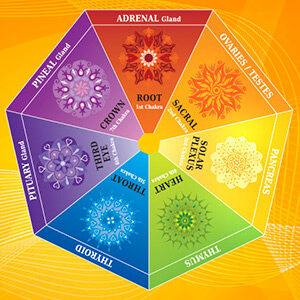“We are not human beings having a spiritual experience.
We are spiritual beings having a human experience.”
Pierre Teilhard de Chardin
The Subtle Body
According to the Hindu Doctrine of the Three Bodies, every human being has three vital bodies, the physical body, the subtle body, and the causal or karmic body. The subtle body is sometimes referred to as the astral body and is described as emanating from the causal body, which is the highest or innermost primal or seed energy. The subtle body has three components, the chakras, meridians, and the aura. The layers of the subtly body connect with the physical body through a complex network of 72,000 energy channels called nadis. The Sanskrit term nadi comes from nad meaning “flow”, “motion” or “vibration”.
The awakening of kundalini is connected to three primary nadis: the central sushumna and the ida and the pingala that intertwine around the sushumna. The shushumna runs up the centre of the spine from the sacrum to the crown and is the main pathway up through which the life force or “prana” rises, energizing the subtle and physical bodies. The ida nadi represents the lunar, feminine and symbolises comfort and nurturing. The pingala signifies solar, masculine traits and exemplifies warmth and stimulation. The two spiral around the sushumna nadi in opposite directions like a helix, visually similar to an uncoiling serpent or the caduceus, symbol of modern medicine, crossing each other at the seven chakras, or energy centres, along the spine finally meeting at a point between the eyebrows at the third eye, or sixth chakra.
It is said that the sushumna channel remains closed at its base until the moment when the kundalini may be awakened. When we breathe efficiently, chant or meditate, we nourish the nadis and the whole subtle body paving the way for the awakening of kundalini. The interconnection of the subtle body with the physical body means the physical body is also nurtured and supported.
The Chakras
Chakra is a Sanskrit word that translates as “wheel” or “vortex” The chakras, like the meridians, are part of the unseen subtle body. The seven main chakras are aligned with the glandular system. Various Kundalini Yoga Kriyas are designed to support the hormone-producing glands including the hypothalamus, pituitary, thyroid, parathyroid, adrenals, pineal, pancreas, ovaries and testes. The chakras are linked to sound, light, and colour as well as the classic elements, earth, water, fire, air, and ether. Each chakra is represented by a specific representative mystical
diagram, traditionally associated with a deity, which is called a yantra and is always depicted with its own specified colour.
1. Root or Base Chakra – “muladhara”
The root chakra sits at the base of the spine at the coccyx. It is the seat of the kundalini. It governs the energy of elimination and is associated with adrenal gland. The yantra is red in colour. Its concomitant element is the first classical element, earth. The root chakra is our base and foundation. It grounds us to mother earth and from there to our heritage, community, and immediate family. Through this chakra we tap into the survival instinct. A healthy root chakra will support a sense of security, strength and self-worth.
2. Sacral Chakra – “svadhisthana”
The second chakra is associated with the spleen and sexual organs. It sits in the sacrum/pelvic area. The yantra is orange in colour. The sacral chakra drives our creative and sexual urges. It provides a source of vitality. It is the seat of sensual emotions and self-gratification. The sacral chakra is associated with change and movement. Its element is water.
3. Navel Chakra –“manipura”
The third chakra sits about two inches above the navel and spreads through the lower torso to end approximately two inches below the heart. It is sometimes referred to as our “core”. It concerns our will, courage, assertiveness, and personal power. The navel chakra, or solar plexus chakra, is depicted in yellow. It is associated with the pancreas and the digestive system in general. Its element is fire. Familiar expressions relating to this chakra are “fire in the belly” or “follow your gut”.
4. Heart Chakra – “anahata”
The fourth chakra is located at the heart centre of the body. Its element is air. Its colour is green, although sometimes it is also depicted with a pink centre. The heart chakra is associated with the thymus gland which lies behind the breastbone, in front of the heart. It governs circulation and respiration and also supports the immune and endocrine systems. It is a mediating chakra that sits between the triangle of the three lower substantial chakras and the upper, ethereal chakras. The heart chakra directs our capacity to love and to feel compassion for ourselves and for others. It is the source of our commitment and conscience.
5. Throat Chakra – “vishuddha”
The throat chakra is the fifth chakra and is associated with the butterfly-shaped thyroid, an endocrine gland. Corresponding with the pharyngeal and laryngeral plexus, the throat chakra governs sound and communication. Its classical element is ether, which in this context refers to the cosmos or celestial heavens. Its yantra is depicted in an aquamarine, sapphire blue. The throat chakra governs self-expression, communication, and speech as well as the ability to listen without judgment. Along with the solar plexus chakra, this chakra is particularly important for chanting mantras. Chanting mantras can be a gateway to successful meditation and in that way is connected to the sixth brow chakra.
6. Brow Chakra- “ajna”
The sixth chakra (sometimes called the Third Eye) is located in the middle of the forehead, just above the eyebrows. It is associated with the pituitary gland. As the “master gland” of the hormonal endocrine system the pituitary gland stimulates the thyroid, adrenal glands and the ovaries and testes. Depicted with an indigo colour, this sixth chakra is the seat of our intuition and higher awareness. It is the channel to our infinite source of wisdom, the union of intellect and intuition. The practice of meditation with breath and chant can increase our intuition and our sense of spiritual connection. Sounding while focusing on the third eye point will develop awareness and proficiency of the frontal skull resonators.
7. Crown Chakra – “sahasrara”
The seventh chakra is associated with the small pee-shaped pineal gland in the brain which regulates various hormones including melatonin. The crown chakra is depicted in a violet colour with 1000 lotus petals to symbolize the expanded, fulsome unfurling of the kundalini energy. It is the gateway to spiritual connection with the Oneness of the Cosmos. A balanced crown chakra allows for connection to the higher self, and union with the Infinite.
The practice of kundalini yoga is designed to awaken the coil of kundalini energy at the base of the spine so that it may move through and connect with, the seven chakras or energy centres that are positioned along the spine and the skull until it reaches the eighth chakra above the skull, which connects us to the Cosmos, the Source, the Universe, and supports a transcendental shift in consciousness.

